Creating a New Pivot Table
Pivot Tables allows you to dynamically summarize large amounts of data for easy analysis and visualization. You can transform data in a table(s) into meaningful summaries easily by using intuitive drag and drop interface provided by ManageEngine Analytics Plus. With Pivot tables you can easily aggregate and filter the values the way you want it.
Creating a Pivot Table
To create a Pivot View, follow the steps given below:
Open the workspace containing the required data with which you want to create a Pivot Table.
Click New Report button in the left top corner to open Create New Report window.
In Create New Report window, click Pivot View (Matrix View). The Select Base Table dialog box opens as shown below.
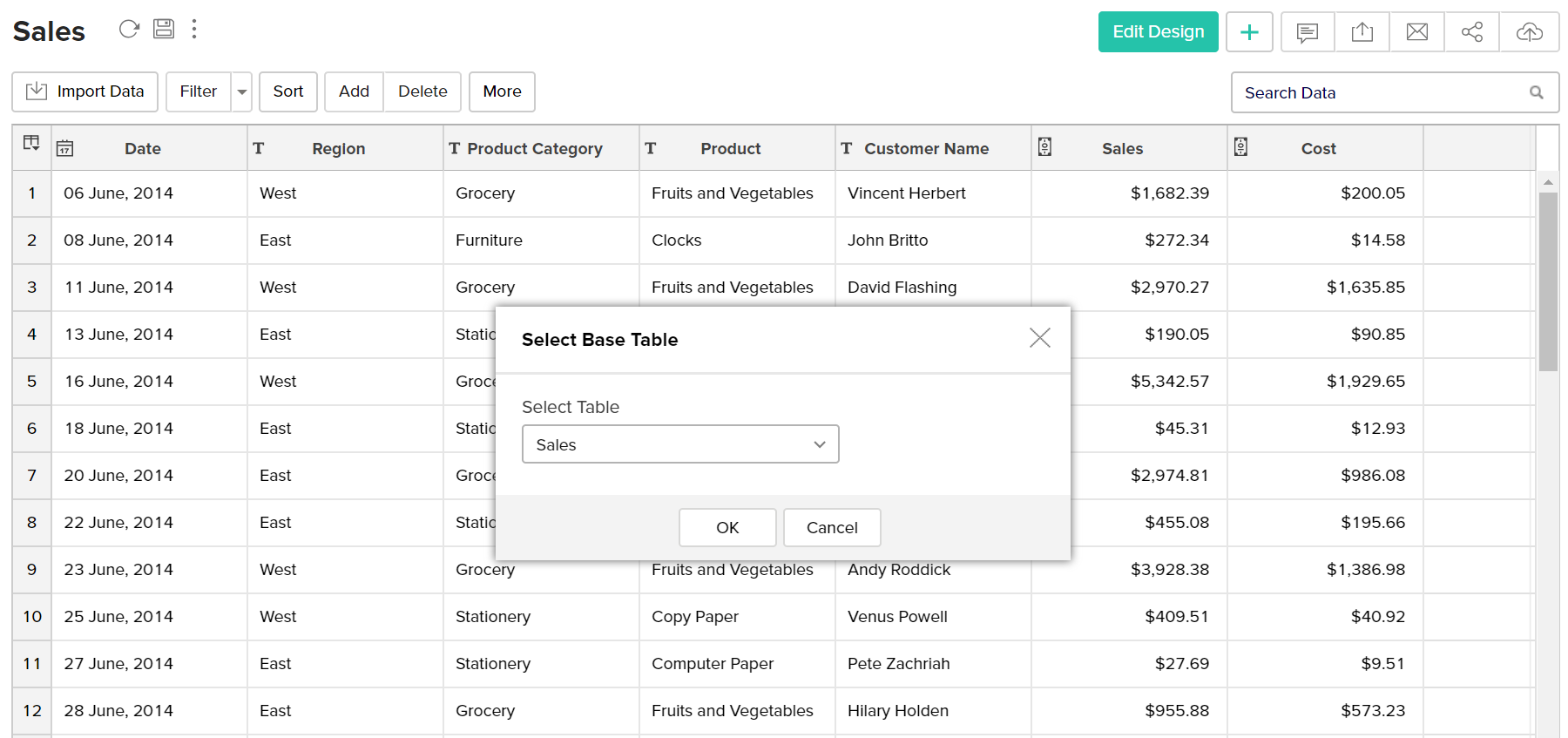
Use Select Base Table dialog box to choose the required table in your workspace on which you want create the Pivot Table and then click OK.
This opens a window in Edit Design mode as shown below:
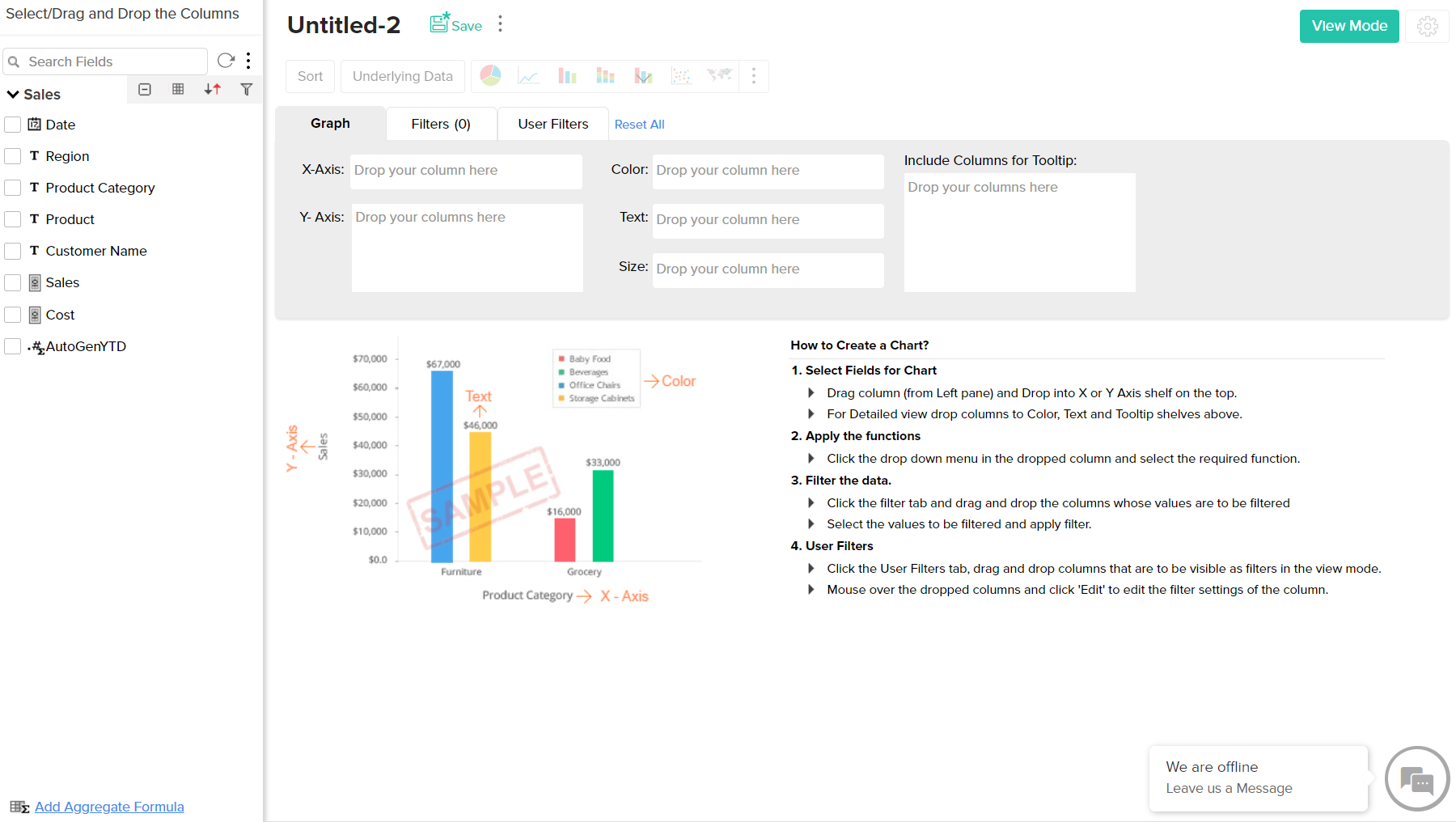
You can also create new Pivot table by opening the corresponding table on which you want to create the pivot table and invoking the New - > New Pivot View option in the toolbar. In Edit Design mode, you will notice that all the columns of the selected table listed as drag and drop items on the left side Column List pane. On the right hand side, you can see the Design Area with shelves to drop the columns and preview area below to view Pivot created.
Note:
- If multiple tables in the data base are connected using a Lookup Column then all the column of the related tables will be listed in the Column List Pane
- Drag and drop the required columns listed in the Column list pane into the respective shelves in the Pivot tab. You can also select the check box adjacent to each column listed to auto place the columns into the appropriate shelves. After dropping the columns click on the option Click here to Generate Pivot to create the new Pivot Table.
Below is a brief description of each of the shelves in the Pivot tab.
Column: Distinct data values present in the columns dropped in this shelf will appear as the column headers of your pivot table. You can also have multiple columns dropped in this shelf for summarization. When you add multiple columns, they will be displayed as categorized layers (group within group) of data vertically.
Row: Distinct data values present in the columns dropped in this shelf will appear as the row headers of your pivot table. You can also have multiple columns dropped in this shelf for summarization. When you add multiple columns, they will be displayed as categorized layers (group within group) of data horizontally.
Data: Values of the columns dropped in this shelf will appear in the body of the pivot table. Values will be summarized based on the summary function that you select. Also it will be categorized to provide the appropriate summary value for each cell corresponding to the row and column value in the table. You can also have multiple columns dropped in the Data shelf for summarization.When you add multiple columns to the data shelf, you can choose to display the values either as rows or columns.
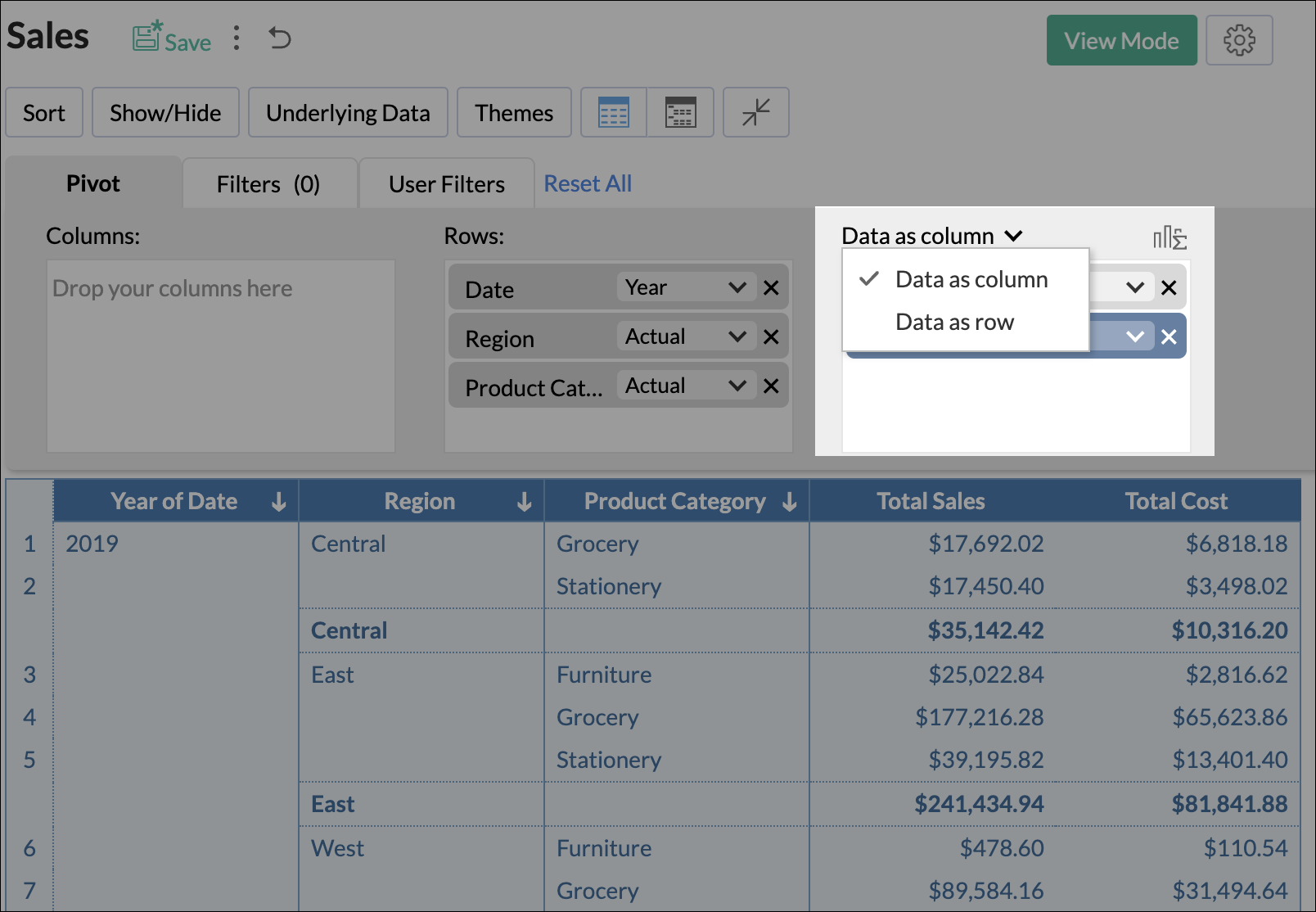
- Once you have created the required Pivot Table, click Save button in the toolbar to save the view. In the Save As dialog box that appears, type the Name, Description for the Pivot Table and choose the folder where the view is to be saved and click OK.
In the example shown below, pivot table summarizes the data in the above table and presents the total sales in each region grouped by each year. In this example, the pivot table has Date column in Column shelf, Region column in Row shelf, and Sales column in Data shelf. Sales in each region is displayed using a Sum aggregation. Also, ManageEngine Analytics Plus automatically summarizes (in this example it is addition) the values of each row and column based on the summary function that you select. Summary row and column will be added at the bottom and to the right of the pivot table.
Functions that are applied on each of the column in the example here are:
Date - Year (all distinct years in the column will be displayed)
Region - Actual (all distinct values in the column will be displayed)
Sales - Sum (sum of the values in the column will be displayed)
You can also change a data column to use any one of the other functions like: Sum, Count, Average, Standard Deviation etc., depending on the data type of that column, which will be discussed in the next section.
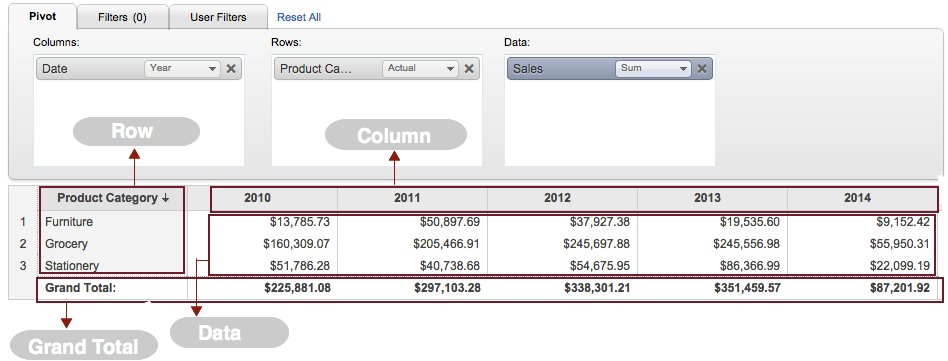
Multiple columns in Row, Column and Data Shelves
Columns/Rows shelf
Analytics Plus allows you to drop multiple columns (up to 15 columns) on each shelf. When you have more than one column in the Column or Row shelf, Analytics Plus automatically groups data in the order they appear from left to right or from top to bottom.
For example, if you have Region and Product Category columns in the Rows shelf, all Product Categories will be grouped for each Region. Similarly, you have Date as Year and Date as Quarter in the Columns shelf, then all 4 Quarters are grouped for each distinct year. Analytics Plus also provides the corresponding summary information.
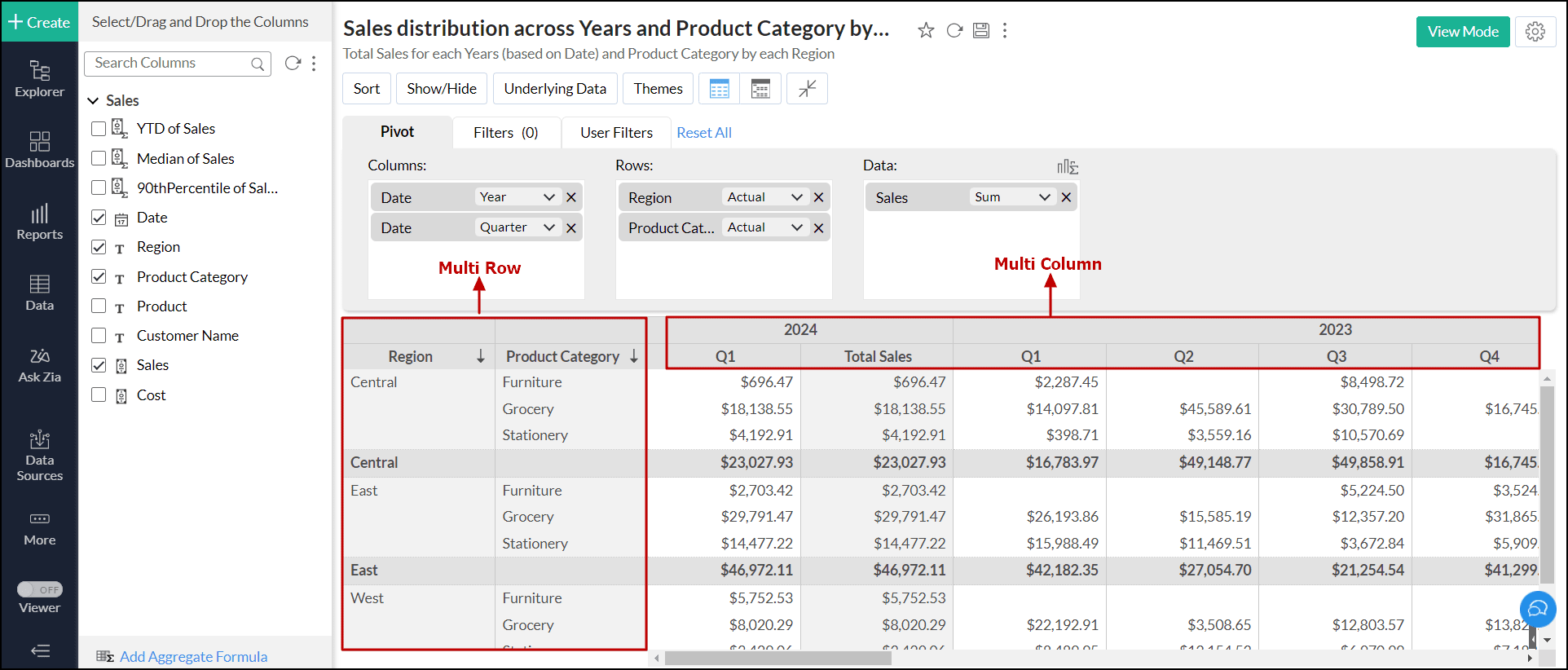
Data shelf
Analytics Plus allows you to add one or more columns to the Data shelf. On adding multiple columns, Analytics Plus enables you to display the data in one of the following formats: Data as Column and Data as Row.
Data as column
Data as column is the default format used in pivot views. In this format, when you drop multiple columns into the Data shelf, the columns will be arranged horizontally as separate columns in the pivot table as shown in the below image.

Data as row
The Data as row option is applicable only when multiple columns are added to the data shelf. Selecting the Data as row option will transform all the total columns as rows under the column header Data Column. However, you can rename the column header as required by double-clicking it. In the below image, Total Sales and Total Cost are expressed in Data as row format.
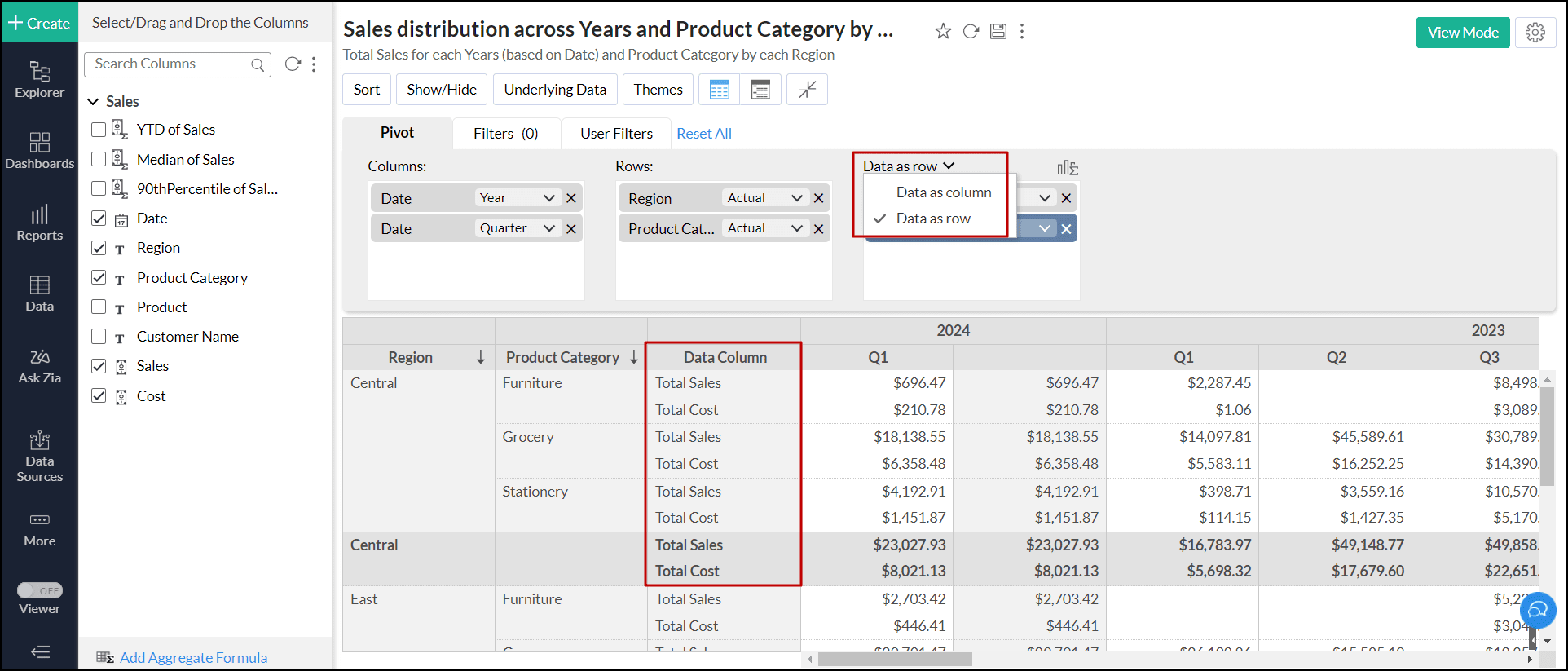
Summary Rows and Columns
When you create a Pivot Table, ManageEngine Analytics Plus automatically adds summary rows and columns to it, based on the summary function that you select. A row displaying summary values of each group of data will also be added, if you have added more than one column to the Row shelf of your Pivot Table. For each column dropped in the Data shelf there will be a summary column added to the right of the pivot table.
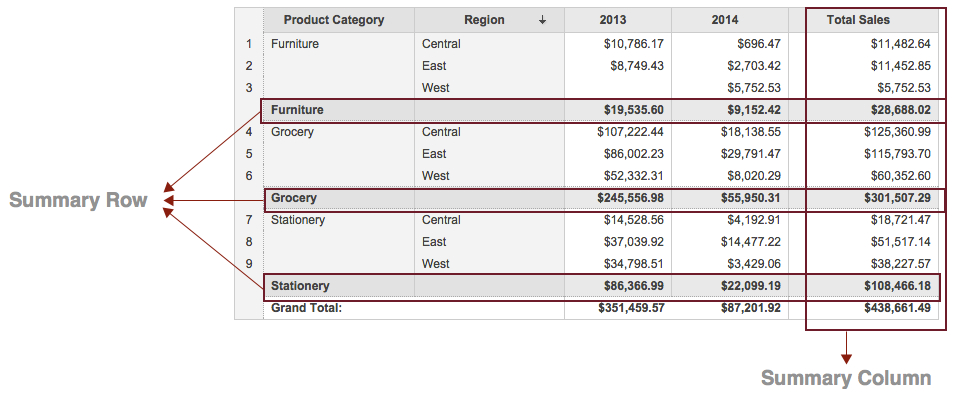
Layout
Analytics Plus allows you to customize a pivot's layout, based on the columns dropped in the Row shelf. The following are the available layouts.
Tabular layout
The default layout of pivot tables, this layout displays the values in the Rows shelf as separate columns in the pivot table.
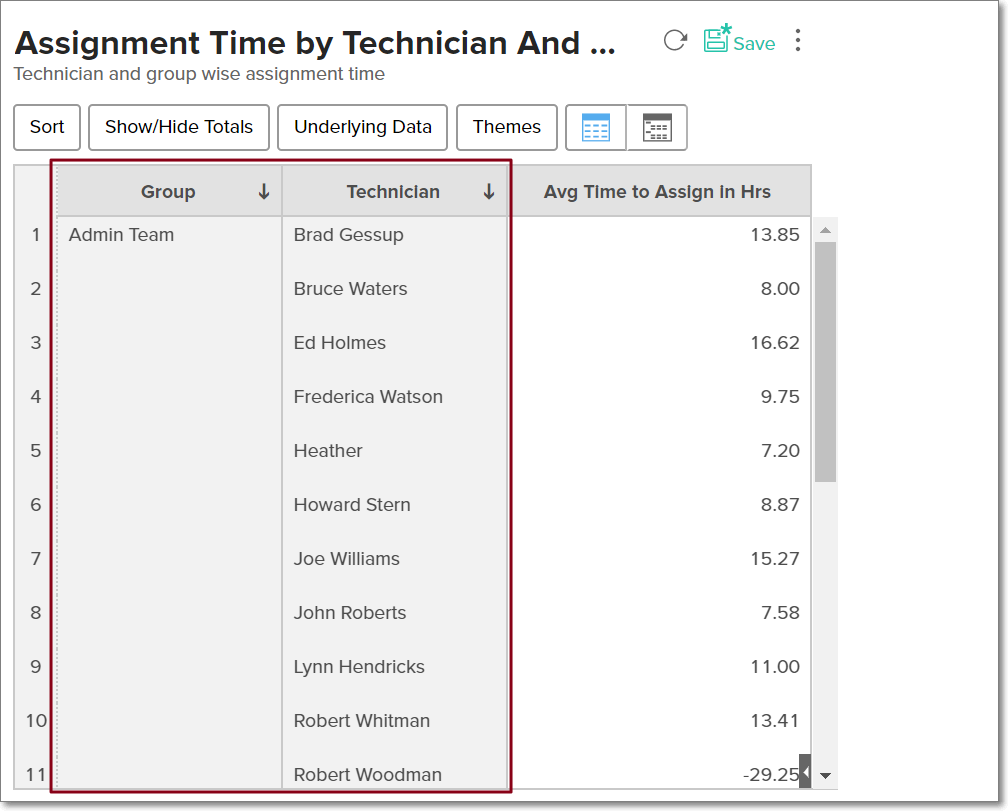
Compact Layout
A close packed view of the pivot table, this layout groups and displays the values in the Rows shelf as a single column in the pivot table.
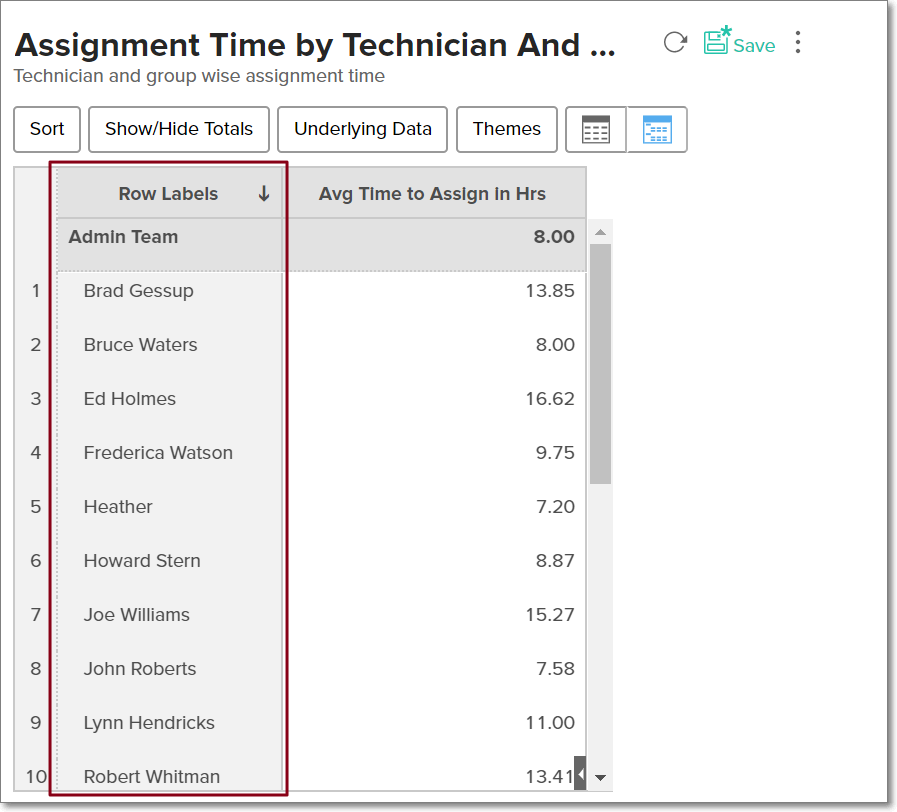
Note: The compact column that displays the values dropped in the Row shelf will be named Row Labels. To modify the name, in the Edit Design mode of the pivot, navigate to the Row Label column and click the Edit icon that appears near the column name on mouse over. Modify the name as needed, and hit Enter.
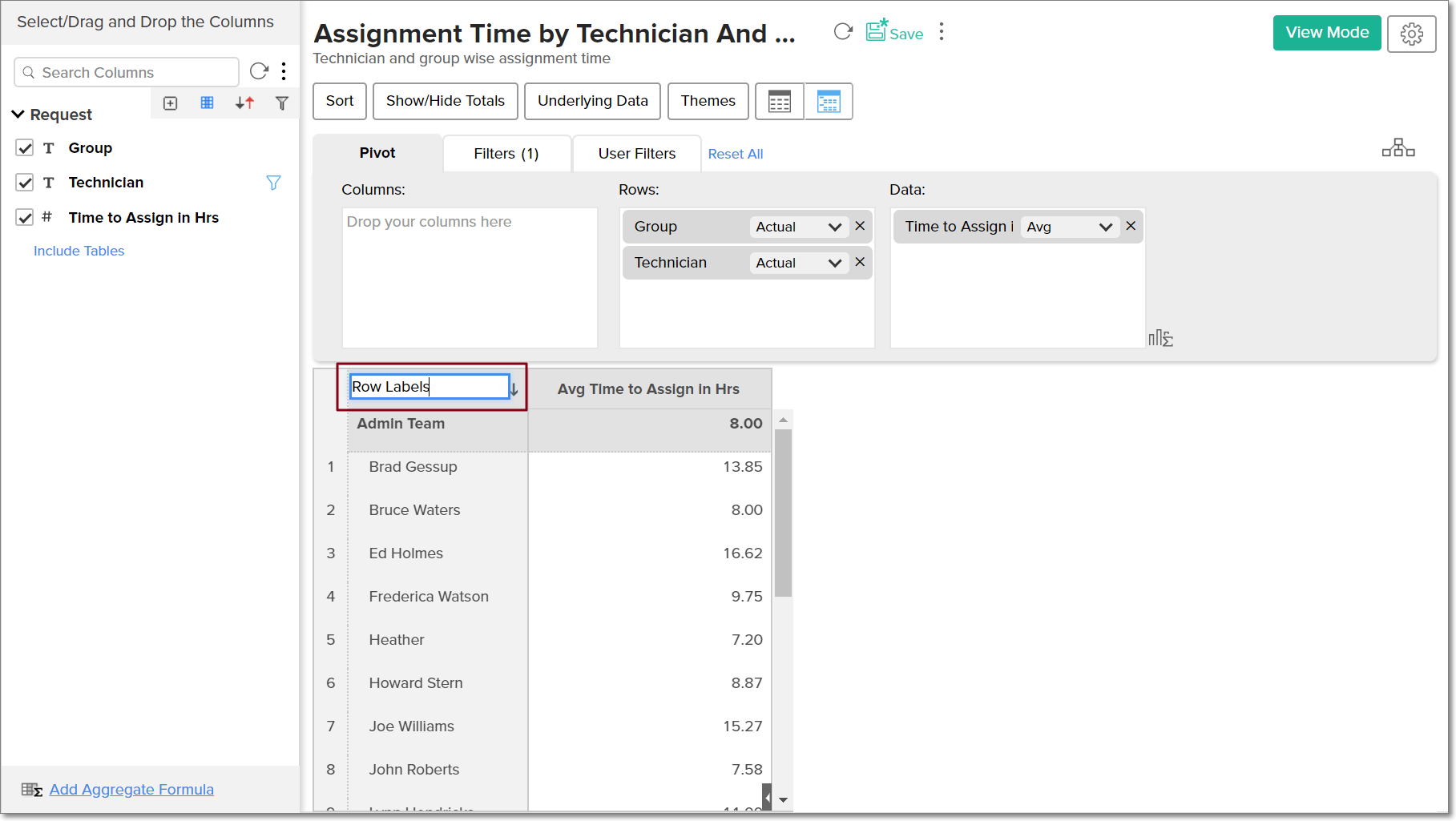
To learn more about editing the pivot layouts, click here.
Applying Functions on Columns
ManageEngine Analytics Plus allows you to apply functions like Sum, Count, Average, Min, Max, Year, etc., on the columns to group and summarize data in the Pivot table you create. When you apply a function on a column, a single value will be returned, derived based on the values in the column
In ManageEngine Analytics Plus, list of Aggregate/Categorical Functions that you can apply on a column varies depending on the data type of the column. The default function for a Numeric (including Currency) data type is Sum and for a Date data type it is Year. If the data type of the column is a string (Categorical/Dimension column) and not numeric, then the default function applied is Actual Values.
To change the default function applied:
In the Pivot Table Edit Design mode, after dropping the column select the required function (aggregate/categorical) from the drop-down list present on the column. Drop-down list displays all the applicable functions based on the data type of the column, as shown in the screen-shots below.
Once you select the aggregation that you would like to use, click Click here to Generate Pivot link or View Mode button in the toolbar.
For instance if you want to Summarizing data like finding the average sales of each product by product category in each region, select Average function from the drop-down list for Sales (Data) column and then click Click here to Generate Pivot link or View Mode button in the toolbar.
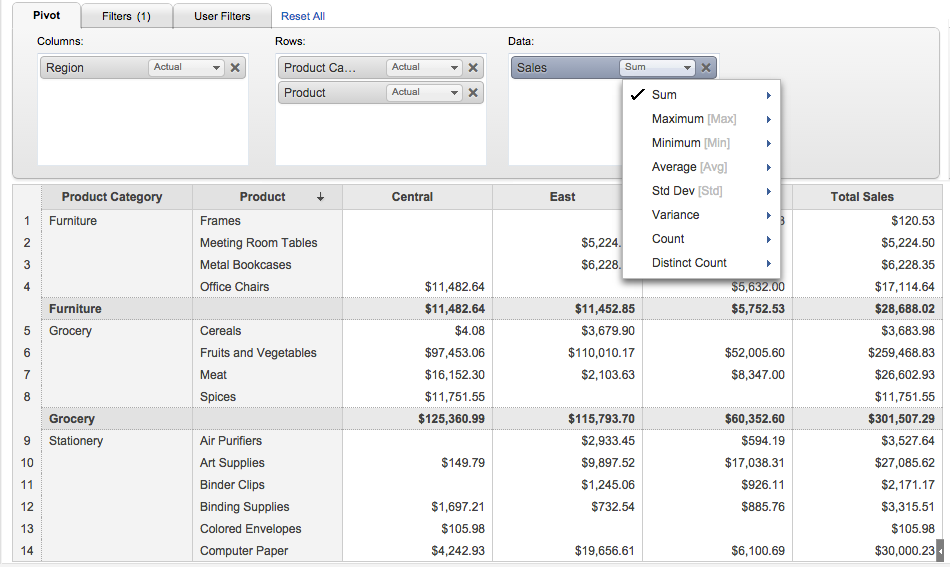
The following tables list all the functions along with the description of their functionality that are applicable for Rows and Columns field.
Numeric and Currency Data Types:
| Funtion | Description |
| Dimension | Treats the values in the column as a textual (categorical/dimensional) value. Returns each distinct value present as a text value. |
| Range | Groups the entire range of numeric values present in the column into multiple ranges. E.g., 0 to 100, 101 to 250 etc., |
Date Data Type - Actual values:
| Funtion | Description |
| Year | Returns all distinct year values present in the column. E.g.,2007, 2010 |
| Quarter & Year | Returns all distinct quarter values present in the column. E.g., Q1 2010 |
| Month & Year | Returns all distinct month values present in the column. E.g., March 2010 |
| Week & Year | Returns all distinct week values present in the column. E.g; W1 2010 |
| Full Year | Returns all distinct dates present in the column date. E.g., 1/1/2011 |
| Date & Time | Returns all distinct date and time pairs present in the column. E.g. 01/12/2010 00:10:07 hrs. |
Date Data Type - Seasonal Value:
| Funtion | Description |
| Quarter | Helps identifying seasonal trends based on quarter across all years. E.g., Q1, Q2. |
| Month | Helps identifying seasonal trends based on months across all years. E.g., January, February. |
| Week | Helps identifying seasonal trends based on weeks across all years. E.g., Week 1, Week 2. |
| Week Day | Helps identifying seasonal trends based on week day across all years. E.g., Sunday, Monday. |
| Day of Month | Helps identifying seasonal trends based on day of month across all dates. E.g., 1 to 31. |
| Hour of Day | Helps identifying trend across hours in a day. E.g., 0 to 23hrs. |
String(Categorical/Dimension) Data Type:
| Funtion | Description |
| Actual Values | All the distinct values in the column will be listed. |
The following tables list all the functions along with the description of their functionality that are applicable for Data field.
Numeric and Currency Data Types:
| Funtion | Description |
| Sum | Returns the sum of all the values in the column. The summation will be done at each category/group level. |
| Maximum [Max] | Returns maximum values in the column. |
| Minimum [Min] | Returns minimum values in the column. |
| Average [Avg] | Returns Arithmetic mean of all the values in the specified column. |
| Standard Deviation | Returns the standard deviation of the column. |
| Variance | Returns the variance of the column. |
| Count | Returns a count of number of values in the column. |
| Distinct Count | Returns the number of distinct value in the column. |
Date Data Types:
| Funtion | Description |
| Count | Returns the number of date values in the column. |
| Distinct Count | Returns the number of distinct date value in the column. |
String(Categorical/Dimension) Data Type:
| Funtion | Description |
| Count | Returns the number of values in the column. |
| Distinct Count | Returns the number of distinct value in the column. |
Advanced Summarizing Options:
When creating pivots, you can choose how to summarize data i.e., by Sum, Max, Min, Average or by Count in a column, depending on its data type. Apart from these, ManageEngine Analytics Plus also provides advanced summarizing options, which allows you to summarize data values in a column based on other values in the column. For example, you can display the percentage of Row in Group, which displays the data in each cell as a percentage of the total value, of each row within a group.
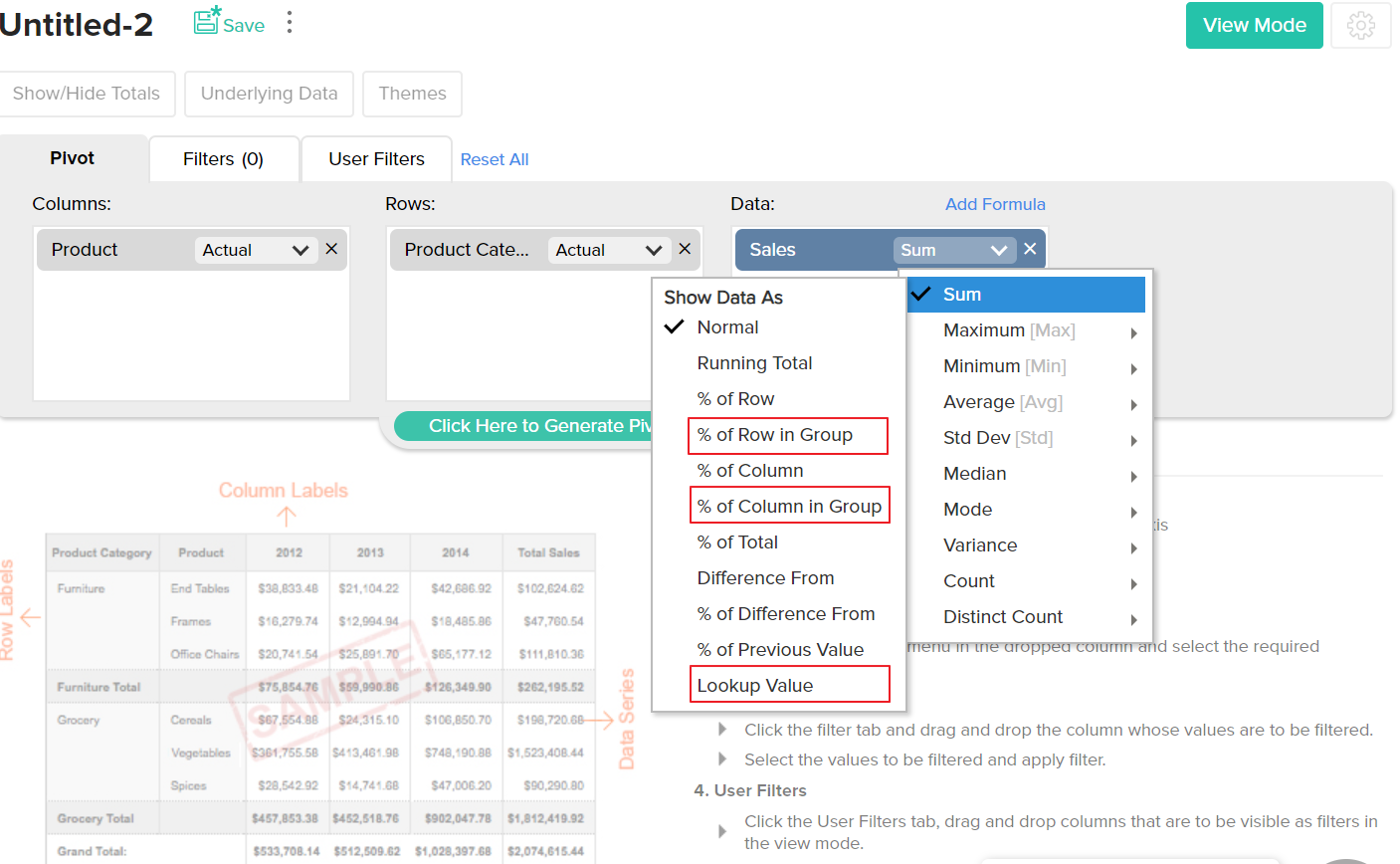
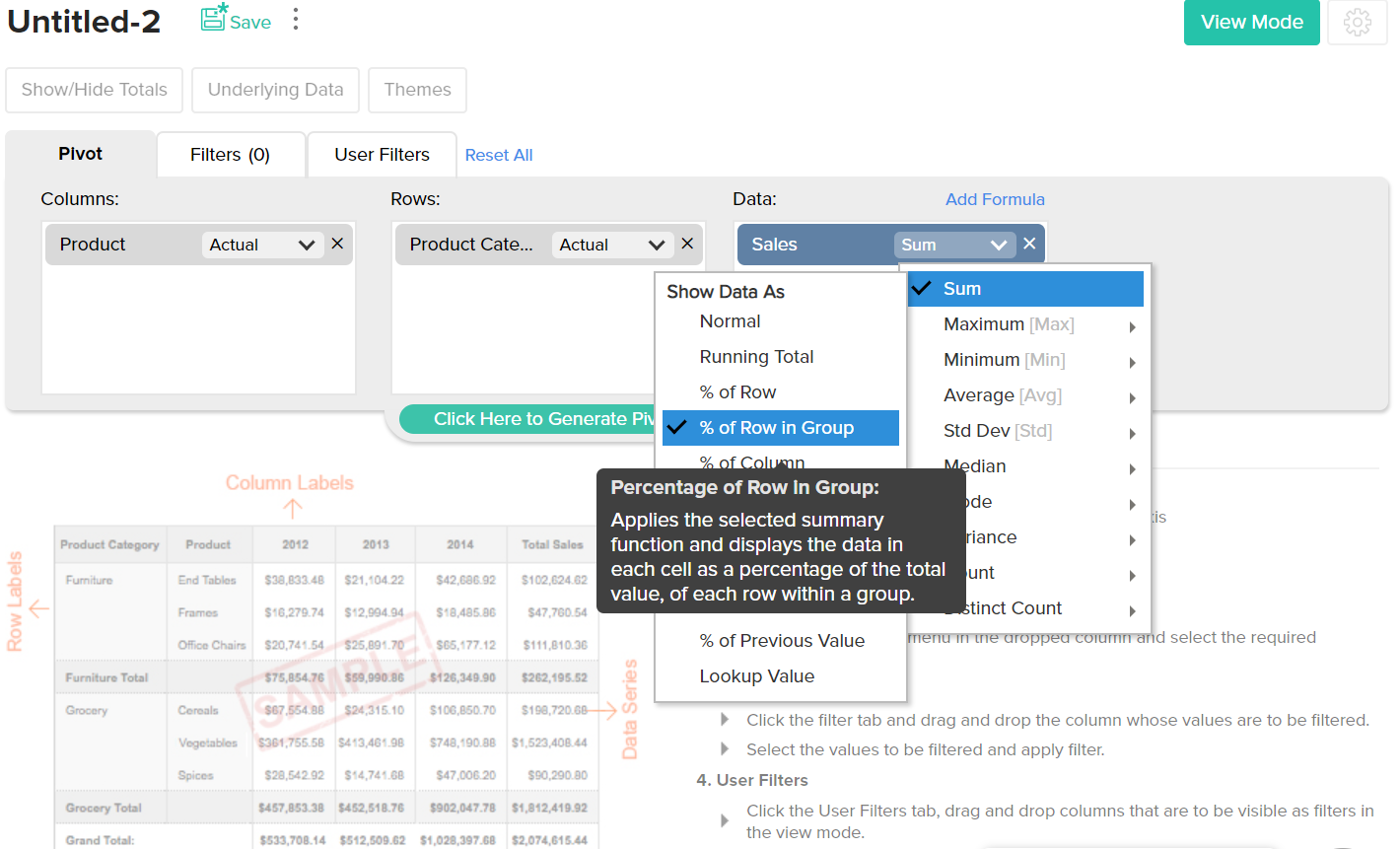
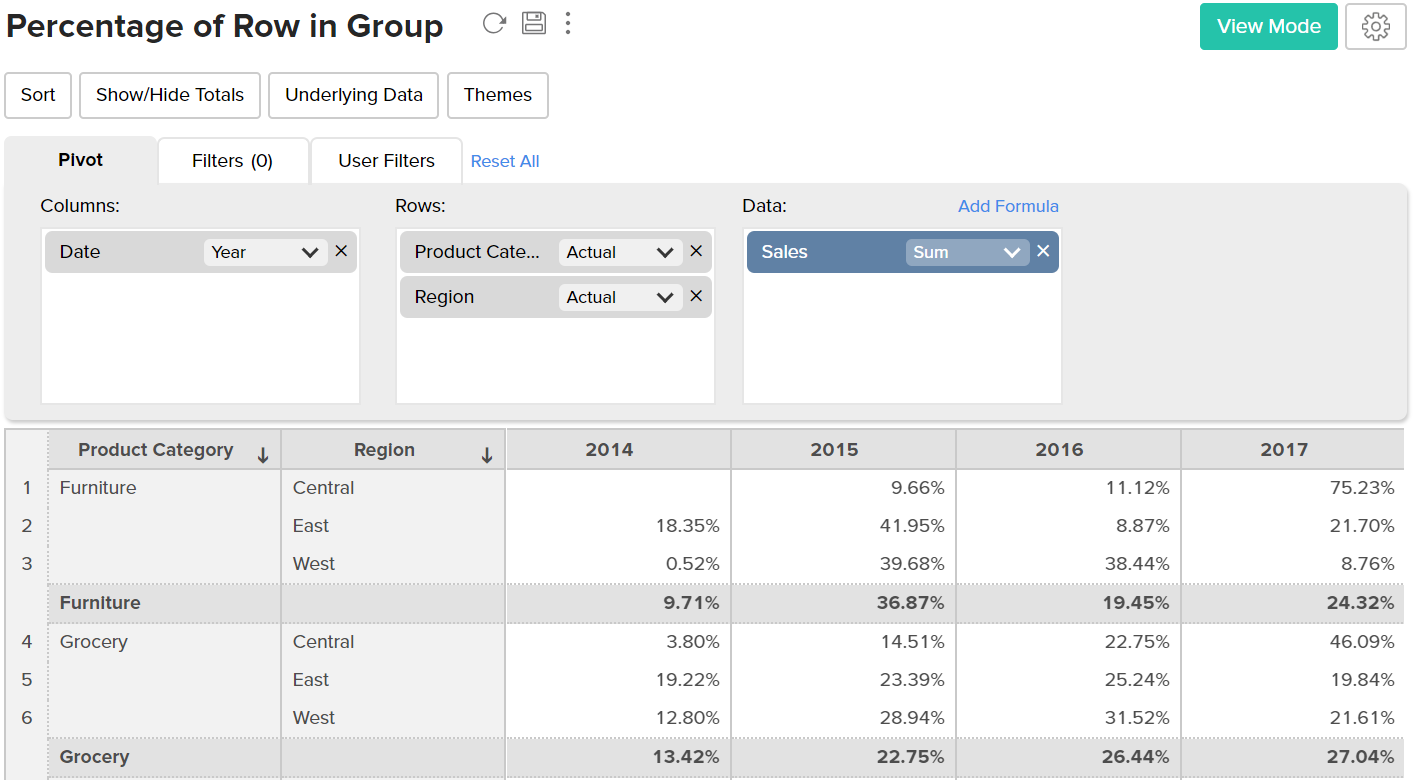
Following are the functions available for advanced summarization:
| FUNCTION | DESCRIPTION |
| % of Row | Displays data as a percentage of the total for each row. |
| % of Column | Displays data as a percentage of the total for each column |
| % of Total | Displays values as a percentage of the grand total of all the data in the report. |
| % of Row in Group | Displays data in each cell as a percentage of the total value, for each row within a group. |
| % of Column in Group | Displays data in each cell as a percentage of the total value, for each column within a group. |
| Lookup Value | Displays data in each cell by fetching valyes from either the Previous/Next/First/Last cell, based on the Base Field selected. |
| Running Total | Displays data in successive cells of the report as a running total. You must select the base field based on which you want to show the items in a running total. |
| Difference From | Displays the data in each cell as the difference from the value in the previous cell, based on the base filed provided. |
| % of Previous Value | Displays the data in each cell as a percentage of the value in the previous cell, based on the base field provided. |
| % of Difference From | Displays the data in each cell as a percentage of differences from the value in the previous cell, based on the base field provided. |
Applying Filters
A useful feature of pivot tables is that you can filter columns, to display only required data. ManageEngine Analytics Plus allows you to filter a column for specific ranges, individual values, date ranges, etc. Depending on the data type of the column. ManageEngine Analytics Plus offers various filtering options like filter based specific numeric ranges, date ranges, individual values, top 10, bottom 10 etc., ManageEngine Analytics Plus also allows you to apply multiple filters (based on multiple columns) on a pivot . The filtering option discussed in this topic can be applied only when you are designing a Pivot Table (i.e when you are in design mode) and not in (pre) view mode.
To apply a filter, after you have created the required Pivot view:
Click Edit Design option in the tool bar.
Click Filters tab next to the Pivot tab in the Design Area.
Drag and drop the required columns in to the Filter shelf.
Once a column is dropped, a list of all possible options for filtering data will be displayed in the box right to Filter shelf as shown in the screen shot below.
Filter Options vary depending on the data type of the dropped column.
After you have dropped the column, select one or more values to filter by. Selected filter items appears in the third box on the right.
Click Click Here to Generate Pivot link or View Mode button in the toolbar. Data that matches the filter values that you have applied will be displayed. However, if you want to exclude specific data from the view, select Exclude Items option in the drop down list at the top of the filter items box.
The Filtering options are the same for all types of reports that you create in ManageEngine Analytics Plus namely charts, pivot table & summary views. The filtering options provided varies based on the data type of the column dropped. Refer to Filters section under Charts topic to know about various Filter Options and more.
Providing User Filters
ManageEngine Analytics Plus also allows you to include dynamic filters capability in the Pivots view mode called User Filters. User filters enables your users who access the report, to apply filters on the report data displayed using the filter columns exposed as part of User Filters. The filter columns included in User Filters can be displayed using a variety of display components like Drop Down boxes, Slider, Date range chooser etc., to suit your needs.
